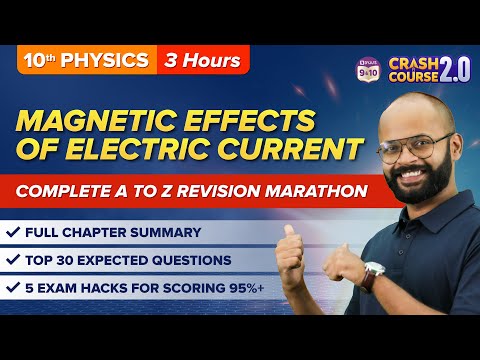An electric current flows across a wire and acts like a magnet. These wire coils are called electromagnets in terms of the magnetic effect of electric current. The magnetic effect can be eliminated if an electric current does not flow through. A magnetic field is a force field produced by magnetic dipoles and moving electric charges, exerting a force on other magnetic dipoles and adjacent moving charges. The magnetic field has both magnitude and direction, so it is a vector quantity.
Read More – Magnetic Effect of Electric Current
Watch the video and solve NCERT exemplar Questions in the chapter Electricity Class 10 Science

Important Questions with Answers
1. Define magnetic field lines.
Michael Faraday invented magnetic field lines to see the magnetic field. A magnetic field line, also known as a force line, represents the strength and direction of a magnet’s force.
2. What is the strength of the magnetic field line?
A magnetic field in concentric circles surrounds a straight current-carrying conductor. Magnetic field lines can describe the magnetic field of a current-carrying straight wire. The current direction represents the direction of a magnetic field developed by a current-carrying conductor.
When the direction of the electric current varies, the magnetic field switches.
3. What is the direction of field lines?
The magnetic field lines of magnets are directed from the north pole to the south pole and from the south pole to the north outside the magnet.
4. State and explain the right-hand thumb rule.
Suppose you were holding a straight current-carrying conductor in your right hand, and your thumb indicates the current direction. Now wrap your finger around the conductor, so here the direction of your fingers will be the direction of the magnetic field lines. The right-hand thumb rule is also known as Maxwell’s corkscrew rule.
5. State Fleming’s right-hand rule.
Suppose you arrange your right-hand thumb, middle finger, and forefinger perpendicularly. In that case, your thumb will indicate the magnetic force’s direction, the middle finger will point in the current’s direction, and the forefinger will point in the magnetic field’s direction; this is the statement of Fleming’s right-hand rule.
6. Why don’t two magnetic lines of force intersect?
The resulting force on a north pole at every point can only be in one direction, which is why the magnetic lines of force do not intersect. However, if the two magnetic lines of force intersect, the resultant force on a north pole placed at the point of intersection can be in the opposite direction, which is not possible.
7. Define the term electromotive force.
The motion of a magnet about the coil causes an induced potential difference. This induced potential difference is known as electromotive force, and it causes an induced electric current to flow in the circuit. An induced potential difference is produced when a magnet moves towards a coil.
8. What is a solenoid?
A solenoid is an instrument made up of a coil of wire. A solenoid can be used as an electromagnet.
9. What is the significance of the current magnetic effect?
The magnetic effect of electric current is one of the essential effects of electric current in use, without which we would not be able to have motors in the modern world. A current-carrying conductor generates a magnetic field that can be visualised using force or magnetic field lines.
10. Write a brief note on the direct current.
A motor-generator set or an inverter can also be used to convert direct current to alternating current. Direct current power is typically used in low-voltage applications like battery charging and light aircraft electrical systems. The unidirectional flow of electric current is known as direct current. The current in direct current flows in a single direction at a constant voltage. The flow of current does not alter regularly. A rectifier is used to convert alternating current to direct current. A rectifier comprises electrical or electromechanical components that allow current to flow solely in one direction.
The below video helps to revise the chapter Magnetic Effects of Electric Current Class 10

Practice Questions
1. Who discovered the magnetic effect of current?
- Hans Christian Oersted
- Micheal Faraday
- Andre Marie Ampere
- None of the above
2. The right hand thumb rule is also known as Maxwell’s corkscrew rule.
- True
- False
3. What is the application of the magnetic effect of electric current?
4. Magnetic field is a scalar quantity.
- True
- False
5. What is a magnetic field?
|
Related Links |
To learn more about the Magnetic Effect of Electric Current, watch the video below.

Stay tuned to BYJU’S for more exciting questions with solutions. Register for “BYJU’S – The Learning App” as well for a wide variety of interactive, engaging physics-related videos.
